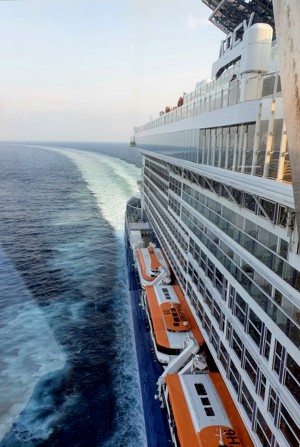Getting to Lichtenburg, where our family live when in town, is easier than in the past. The new (and very long awaited) Berlin Brandenburg Airport (BER) "Willy Brandt" is where the old Schönefeld regional airport was - but now the station is in the airport and the connection, at Ostkreuz, doesn't require lugging bags from S-Bahn to U-Bahn as was once the case to-or-from Schönefeld.
It's also closer and much improved on that terrible old Tegel airport where they once lost my bag.
The Berlin apartment is much the same as it was last trip but the children are growing and becoming more competent, just as a proud grandparent expects.
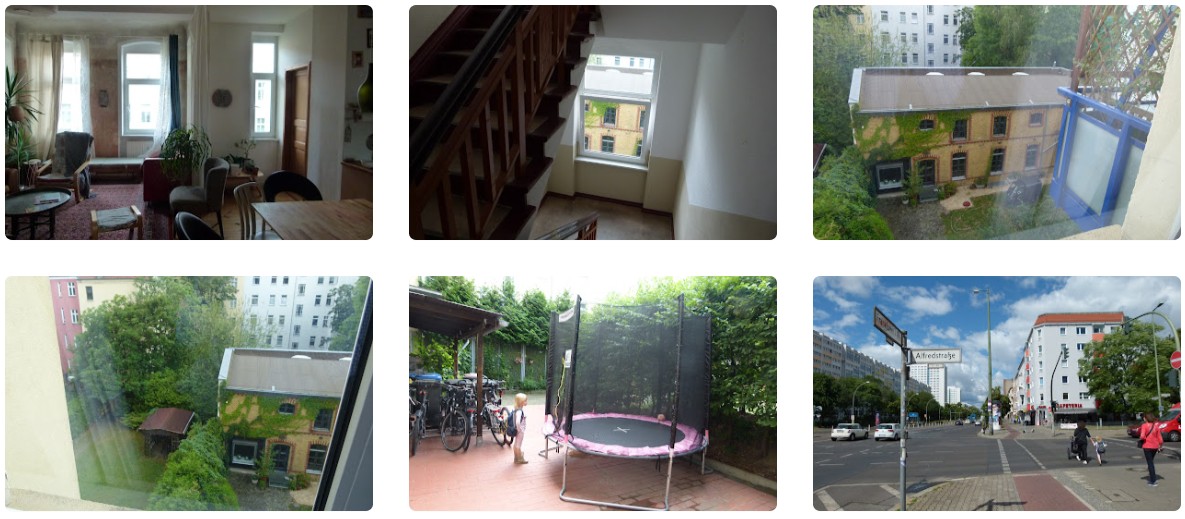
The large road nearby (in the photograph above, bottom right), is Frankfurter Allee, under which the U-Bahn (metro) runs.
At Strausberger Platz it becomes Karl-Marx-Allee. This was re-built as a monumental boulevard during the DDR (Deutsche Demokratische Republik - East Germany), having been totally levelled by the RAF (British Royal Air Force) during WW2. The low-level bombers used this street and the adjacent railway to navigate their way into the city centre, bombing all the way, thus new, soviet-style, apartment buildings replaced the ruins along here as the city recovered.
Contrary to poplar belief and western propaganda, these were much sought after as they had: lifts, bathroom and toilets and hot and cold running water in the kitchens.
Emily and Guido's block, on the other hand, a couple of hundred metres away, was structurally sound and was comprehensively repaired. The internal bathrooms and modern kitchens had to be retro-fitted. There are still no lifts and the high ceilings result in more stairs. But coal fires and stoves, that once heated the city, are gone and every (legal) dwelling is centrally heated and double-glazed. Yet, not everyone is so well-off. Like every large city Berlin has some rough sleepers.
For most trips to and around the city Magdalenenstraße U-Bahn station is nearby and the most convenient of several public transport options.
It's also historic and interesting. It retains its East German character, with murals depicting the Marxist battles for workers' freedom and rights: including revolutionary struggles and, of course, two world wars.

This was the nearest station to the Stasi headquarters - now a museum - two blocks over from Emily and Guido. I've talked about that at length after earlier trips.
In 1995, after reunification, these paintings were to have been covered by advertisements, but this was prevented by the culture department of the Berliner Senat and they were again preserved when the station was renovated in 2004-05.
Fortunately, in my opinion, the Berliners are not (yet?) into historical revisionism. No knocking down Robert E Lee statues or objecting to Captain Cook, that otherwise record that past, without which, none of us would be here.
Berliners still love their Ampelmännchen (little traffic light man), who still regulates pedestrians in what was the Eastern sector, too.
The city retains both a Karl-Marx-Straße and a Karl-Marx-Allee (previously Stalinallee - prior to his disgrace). Stalin lost his various place names under the DDR (who were definitely into historical revisionism).
As a priority, I wanted to show Wendy the Kunstgewerbemuseum (museum of decorative arts), which she had missed on previous visits. It has a big fashion section and I had bought her their: 'Fashion Art Works - 1715 to today' book and she had wished that she had not turned down 'another museum' last time.
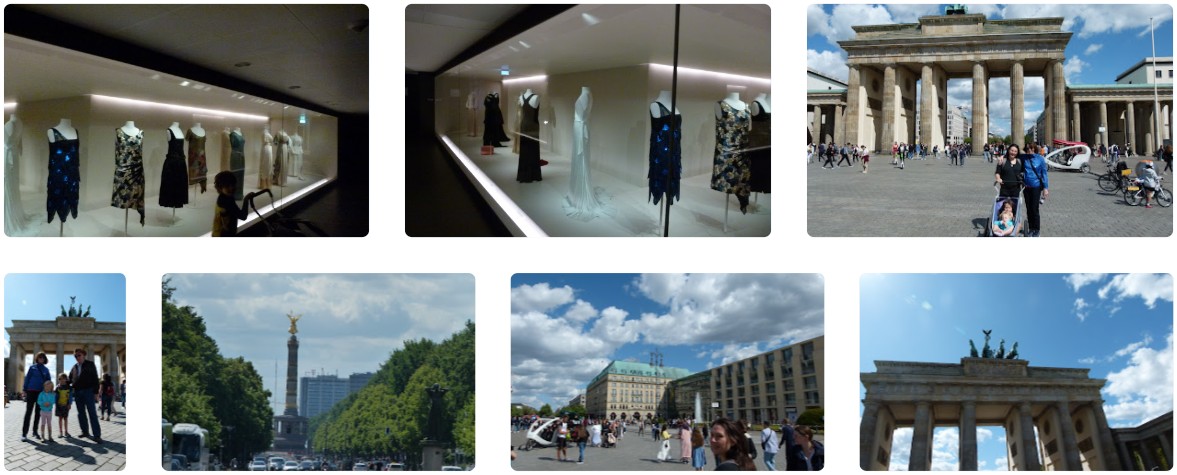
We had some lunch at a pub at Potsdamer Platz and then headed up to the Brandenburg Gate and Unter den Linden.
It's an interesting piece of trivia(?) that since it was restored after the war the chariot on the top of the Brandenburg Gate faces the other way. The gate was in the DDR and, when restoring it, they turned it around, with its back to the Tiergarten, then in western sector of the city. Now, charging into the city, and away from Brandenburg, seems a bit bizarre.
From here I was out-voted on going to an outdoor market - a lot of walking - by which time afternoon tea was in order at a rooftop café.

Tilda is watching a large parade by members of Falun Dafa (Falun Gong), a far-right religious cult that, coincidentally, uses a reverse swastika as its logo.
The cult trades heavily on having been banned in China and on its consequent vehement opposition to Chinese Communism. It supported Q-anon and gave financial and membership support to President Trump's re-election. They are also anti-abortion; Creationist; reject modern (evidence based) medicine; oppose racial mixing; and oppose greater gun-control in the US.
The Australian Broadcasting Commission Foreign Correspondent program investigated the cult in 2020 and you can see the program on YouTube
| No responsibility is accepted for linked third party video or media content - see Terms of Use and Copyright. You follow any YouTube links or advertisements displayed at your own risk. |
Wikipedia tells us:
"Falun Gong extensions include The Epoch Times, a politically far-right media entity that has received significant attention for promoting conspiracy theories, such as QAnon and anti-vaccine misinformation, and producing advertisements for former U.S. President Donald Trump. Shen Yun has also received significant media coverage for its emphasis on, for example, anti-evolution statements and promotion of Falun Gong doctrine, while presenting itself as founded upon ancient tradition."
They were a rather ominous sight, marching in large numbers in Berlin, where people initially laughed at the Brownshirts.
Over the next few days Emily had planned some interesting excursions that would also keep the children amused.

The weather stayed balmy and we enjoyed the outdoors - not to mention the eateries and playgrounds.
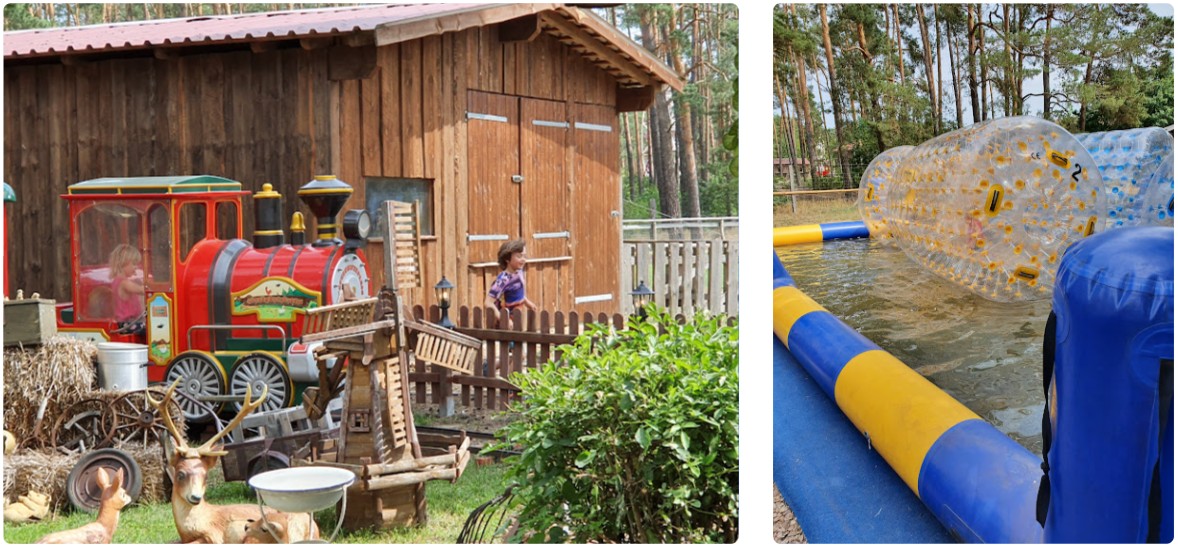
Just over an hour's drive from Lichtenberg (Berlin) is the Brandenburg Forest where there are amazing canopy walks through the forest treetops. A forty-metre-tall viewing tower at the hub has a lift to all levels or if you want some exercise, you can use the stairs, at least to return to earth after your 'spazierengehen' - stroll.

Steel towers, at different heights, support two winding canopy walks. Below, are the ruins of the historic Beelitz Heilstätten hospital now being regained by nature, with trees springing from the very rooftops.

Amazingly, this has taken but a few decades. It was still a fully functioning hospital when the Russians abandoned it in 1995 following German reunification - six years after the fall of the Berlin Wall.

The old hospital was then vandalised and fell into ruins.
It had been the site of one of the last battles between the Russian 'liberators', our WW2 allies, and the remnants of the defeated German 'Nazi' army. It was a reminder of a past many wished to forget.
The victorious Russians had restored it as a hospital and one of its last patients was Erich Honecker, their erstwhile puppet, who had led the German Democratic Republic (DDR, East Germany) for 13 years, and oversaw the building of the Berlin Wall. He came here for treatment for liver cancer in December 1990, thus escaping a planned show-trial and retribution, and died three years later, exiled to Chile. Much of the signage on the buildings is in Russian.
But Beelitz Heilstätten's most famous former patient was a young Gefreiter (corporal), who had been blinded by a British gas attack and wounded in the leg at the Battle of the Somme, earning him his first Iron Cross for bravery (second class - the first class one came later). Without these awards Hitler would never have had the credibility to lead the Munich Putsch and, subsequently, the Nazi Party.
The gas-filled shell may well have been fired by my grandfather who was a British gunnery sergeant in the battle.
My grandfather was also awarded a medal for bravery, the Military Medal. I have speculated on this chance of history on my website see: Adolf Hitler and me
No wonder the hospital was not reinstated. Instead, it was abandoned for an appropriate passage of time, as wounds healed, until its present rebirth as a nature-walk-and-café country excursion.
Long before these events, the hospital began its existence as a 'state of the art' sanitorium for tuberculosis patients.
The architect, Heino Schmieden, and his childhood friend and business companion, Martin Gropius, (grandfather of Walter Gropius of Bauhaus fame) promoted people-oriented, yet beautiful (decorative; pleasingly proportioned?), architecture. They cooperated on the design of the Applied Arts Museum in Berlin. In 1898 Heino Schmieden conceived the Beelitz Heilstätten complex.
Initially a 600-bed recuperative complex, equipped with the latest technologies, it allowed patients to revel in country air and forest walks and to undergo 'state of the art' treatments, like those we saw in Albuquerque, New Mexico, some akin to torture (water-boarding, electric shocks and so on).
According to the spiel online:
"The patient pavilion, which included terraced balconies used for ‘air-bath’ treatments, was divided into four quadrants: the women and men were housed on the west and east ends, respectively; while the north-south axis divided the contagious, quarantined patients from the others. In 1908, the site was expanded to accommodate 1200 beds, and the hospital became a city unto itself, with its own post office, restaurant, nursery, bakery, butcher shop and stables, as well as two kitchens and two laundry houses."
I found it all very interesting.

But none of this interested the grandchildren, they just love running the canopy walks and, in particular the cage-like tunnels that curve over and under the walkway, tens of metres above the forest floor.
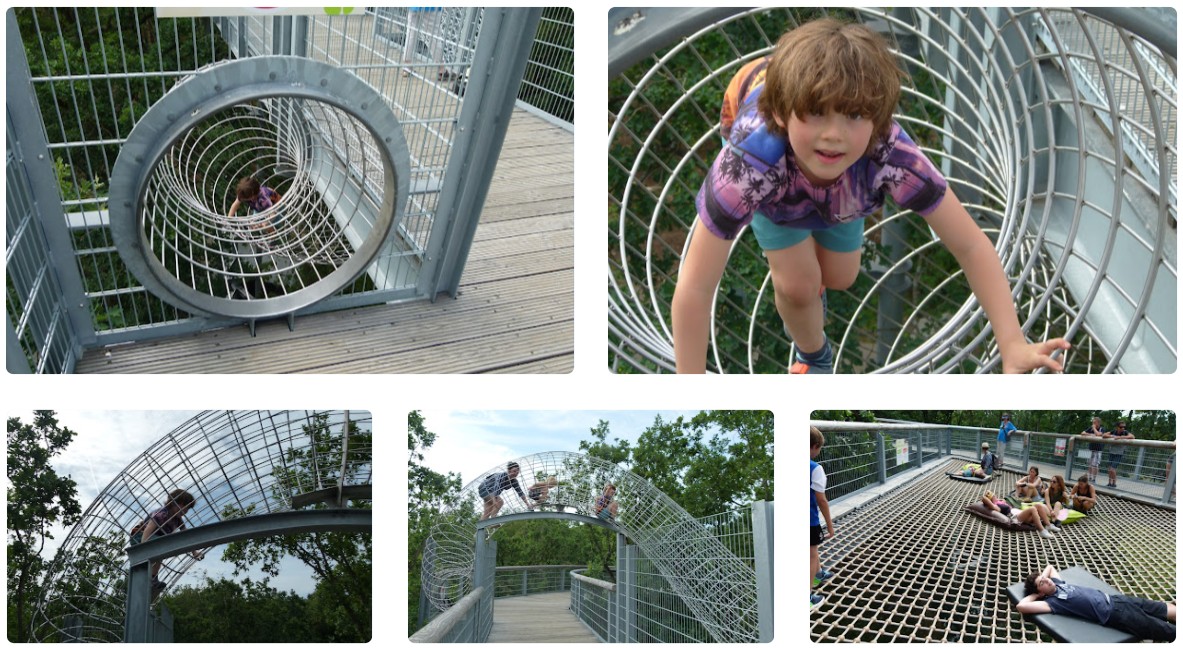
Not for those afraid of heights.
After our stay in Berlin, we were to fly to Amsterdam to begin a Baltic Cruise.
But before we could go, we needed another, official, Covid test, in addition to our international vaccination certificates (quadruple vaccinations).
This was a small adventure in itself, as the testing station was in a carpark in which vandals had set fire to a small mountain of plastic waste (collected for recycling) and the local fire brigade were in attendance.
We made it in on foot and duly got the required virus-all-clear, jumping over puddles of water as the brigade efficiently dealt with the mess and briefly amused the children.

